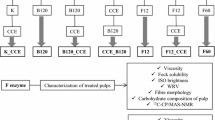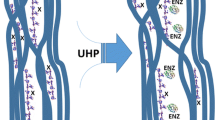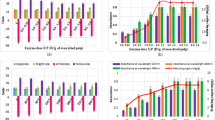Abstract
A TCF sulphite pulp, bleached at the laboratory scale with a laccase–violuric acid system and complemented with a pressurized hydrogen peroxide stage, was treated with two endoglucanases, one obtained from Paenibacillus barcinonensis (B) and the other one produced from Cerrena unicolor (F) to improve cellulose reactivity. The treated pulps were evaluated in terms of brightness, viscosity, α-cellulose, water retention value, fibre morphology, Fock solubility, NMR and carbohydrate composition of pulps and liquors. Results revealed that both endoglucanases improved cellulose reactivity, albeit in a different way; thus, B caused no scissions in the cellulose chain and no significant reduction in fibre length, whereas F decreased viscosity and shortened fibre length, leading to lower reactivity value. The liquor composition of soluble carbohydrates released by the enzymatic treatments revealed the B had a processive mode of action since short oligosaccharides, cellobiose and glucose, were obtained. F hydrolysed, from high to low concentration, cellobiose, glucose and cellotriose. Importantly, environmentally friendly dissolving pulp with 90 % Fock solubility was obtained, combining two enzymatic treatments: a laccase–mediator system and then a cellulase from P. barcinonensis (B). In order to improve the quality of final dissolving pulp, a pulp purification step was introduced before the B endoglucanase treatment. The cold caustic extraction lead to reduce the amount of hemicelluloses by 42 % with respect to biobleached pulp, but Fock solubility was also reduced. However, complementing the purification step with F treatment, reduced the amount of hemicelluloses but also improved Fock solubility by 17 %, although some presence of cellulose II was detected by NMR.






Similar content being viewed by others
Abbreviations
- CCE:
-
Cold caustic extraction
- CS:
-
Chain scission
- DP:
-
Degree of polymerization
- EG:
-
Endoglucanase
- K_CCE:
-
Control treatment with buffer acetate + cold caustic extraction
- L:
-
Laccase–mediator treatment
- L_B120:
-
Biobleached pulp + B endoglucanase at 120 U/g
- L_CCE:
-
Biobleached pulp + cold caustic extraction
- L_CCE_B120:
-
Biobleached pulp + cold caustic extraction + B endoglucanase at 120 U/g
- L_CCE_F12:
-
Biobleached pulp + cold caustic extraction + F endoglucanase at 12 U/g
- L_F12:
-
Biobleached pulp + F endoglucanase at 12 U/g
- L_K:
-
Biobleached pulp + control treatment with buffer acetate
- PO:
-
Hydrogen peroxide reinforced with pressurized oxygen
- TCF:
-
Totally chlorine free
- n.d.:
-
Not determined
- odp:
-
Oven dried pulp
- VA:
-
Violuric acid
- WRV:
-
Water retention value
- 13C-CP/MAS NMR:
-
Solid state cross polarization/magic angle spinning carbon 13 nuclear magnetic resonance
References
Arnoul-Jarriault B, Lachenal D, Chirat C, Heux L (2014) Upgrading softwood bleached kraft pulp to dissolving pulp by cold caustic treatment and acid-hot caustic treatment. Ind Crops Prod. doi:10.1016/j.indcrop.2014.09.051
Bouchard J, Morelli E, Berry RM (2000) Gas phase addition of solvent to ozone bleaching of kraft pulp. J Pulp Pap Sci 26:30–35
Cadena EM, Chriac AI, Javier Pastor FI et al (2010) Use of cellulases and recombinant cellulose binding domains for refining TCF kraft pulp. Biotechnol Prog 26:960–967. doi:10.1002/btpr.411
Cairns JRK, Esen A (2010) Beta-glucosidases. Cell Mol Life Sci 67:3389–3405. doi:10.1007/s00018-010-0399-2
Chiriac AI, Cadena EM, Vidal T et al (2010) Engineering a family 9 processive endoglucanase from Paenibacillus barcinonensis displaying a novel architecture. Appl Microbiol Biotechnol 86:1125–1134. doi:10.1007/s00253-009-2350-8
Chiriac AI, Pastor FIJ, Popa VI et al (2013) Changes of supramolecular cellulose structure and accessibility induced by the processive endoglucanase Cel9B from Paenibacillus barcinonensis. Cellulose 21:203–219. doi:10.1007/s10570-013-0118-x
Ek M, Gellerstedt G, Henriksson G (2009) Pulp and paper chemistry and technology. In: Wood chemistry and wood biotechnology, vol 1. pp 247–249
Engström A-C, Ek M, Henriksson G (2006) Improved accessibility and reactivity of dissolving pulp for the viscose process: pretreatment with monocomponent endoglucanase. Biomacromolecules 7:2027–2031
Evans R, Wallis AFA (1987) Comparison of cellulose molecular weights determined by high performance size exclusion chromatography and viscometry. In: 4th International Symposium on Wood and Pulping Chemistry, pp 201–205
FAO (2012) FAO. Food and Agriculture Organitzation of the United Nations
Fock W (1959) A modified method for determining the reactivity of viscose-grade dissolving pulps. Papier 13:92–95
Garcia-Ubasart J, Torres AL, Vila C et al (2013) Biomodification of cellulose flax fibers by a new cellulase. Ind Crops Prod 44:71–76. doi:10.1016/j.indcrop.2012.10.019
Gehmayr V, Sixta H (2012) Pulp properties and their influence on enzymatic degradability. Biomacromolecules 13:645–651
Gehmayr V, Schild G, Sixta H (2011) A precise study on the feasibility of enzyme treatments of a kraft pulp for viscose application. Cellulose 18:479–491. doi:10.1007/s10570-010-9483-x
Glasser WG, Atalla RH, Blackwell J et al (2012) About the structure of cellulose: debating the Lindman hypothesis. Cellulose 19:589–598. doi:10.1007/s10570-012-9691-7
Henriksson G, Christiernin M, Agnemo R (2005) Monocomponent endoglucanase treatment increases the reactivity of softwood sulphite dissolving pulp. J Ind Microbiol Biotechnol 32:211–214. doi:10.1007/s10295-005-0220-7
Ibarra D, Köpcke V, Ek M (2010a) Behavior of different monocomponent endoglucanases on the accessibility and reactivity of dissolving-grade pulps for viscose process. Enzyme Microb Technol 47:355–362. doi:10.1016/j.enzmictec.2010.07.016
Ibarra D, Köpcke V, Larsson PT et al (2010b) Combination of alkaline and enzymatic treatments as a process for upgrading sisal paper-grade pulp to dissolving-grade pulp. Bioresour Technol 101:7416–7423. doi:10.1016/j.biortech.2010.04.050
Irwin D, Shin DH, Zhang S et al (1998) Roles of the catalytic domain and two cellulose binding domains of Thermomonospora fusca E4 in cellulose hydrolysis. J Bacteriol 180:1709–1714
Janzon R, Puls J, Bohn A et al (2008a) Upgrading of paper grade pulps to dissolving pulps by nitren extraction: yields, molecular and supramolecular structures of nitren extracted pulps. Cellulose 15:739–750. doi:10.1007/s10570-008-9224-6
Janzon R, Saake B, Puls J (2008b) Upgrading of paper-grade pulps to dissolving pulps by nitren extraction: properties of nitren extracted xylans in comparison to NaOH and KOH extracted xylans. Cellulose 15:161–175. doi:10.1007/s10570-007-9154-8
Köpcke V, Ibarra D, Ek M (2008) Increasing accessibility and reactivity of paper grade pulp by enzymatic treatment for use as dissolving pulp. Nord Pulp Pap Res J 23:363–368
Krässig HA (1993) Cellulose-Structure, Accessibility and Reactivity, vol 11. Gordon and Breach Science Publisher, Yverdon, p 376
Kvarnlöf N, Germgård U, Jönsson LJ, Söderlund C-A (2006) Enzymatic treatment to increase the reactivity of a dissolving pulp for viscose preparation. Appita J 59:242–246
Lindman B, Karlström G, Stigsson L (2010) On the mechanism of dissolution of cellulose. J Mol Liq 156:76–81. doi:10.1016/j.molliq.2010.04.016
Lynd LR, Weimer PJ, van Zyl WH, Pretorius IS (2002) Microbial cellulose utilization: fundamentals and biotechnology. Microbiol Mol Biol Rev 66:506–577. doi:10.1128/MMBR.66.3.506-577.2002
Medronho B, Romano A, Miguel MG et al (2012) Rationalizing cellulose (in)solubility: reviewing basic physicochemical aspects and role of hydrophobic interactions. Cellulose 19:581–587. doi:10.1007/s10570-011-9644-6
Moon RJ, Martini A, Nairn J et al (2011) Cellulose nanomaterials review: structure, properties and nanocomposites. Chem Soc Rev 40:3941–3994. doi:10.1039/c0cs00108b
Quintana E, Valls C, Vidal T, Roncero MB (2013) An enzyme-catalysed bleaching treatment to meet dissolving pulp characteristics for cellulose derivatives applications. Bioresour Technol 148:1–8. doi:10.1016/j.biortech.2013.08.104
Quintana E, Valls C, Barneto AG et al (2015) Studying the effects of laccase treatment in a softwood dissolving pulp: cellulose reactivity and crystallinity. Carbohydr Polym 119:53–61. doi:10.1016/j.carbpol.2014.11.019
Quintana E, Valls C, Vidal T, Roncero MB Comparative evaluation of the action of two different endoglucanases. Part I: On a fully bleached, commercial acid sulfite dissolving pulp. Cellulose (under review)
Rahkamo L, Viikari L, Buchert J et al (1998) Enzymatic and alkaline treatments of hardwood dissolving pulp. Cellulose 5:79–88. doi:10.1023/A:1009268713757
Sixta H (2006) Handbook of pulp. Wiley, Weinheim
Spiro R (1966) Analysis of sugars found in glycoproteins. Methods Enzymol. 566:7–9
Zverlov VV (2003) Two new cellulosome components encoded downstream of celI in the genome of Clostridium thermocellum: the non-processive endoglucanase CelN and the possibly structural protein CseP. Microbiology 149:515–524. doi:10.1099/mic.0.25959-0
Acknowledgments
The authors thank the "Ministerio de Economía y Competitividad" of Spain for their support in this work under the projects BIOSURFACEL CTQ2012-34109 (funding also from the "Fondo Europeo de Desarrollo Regional FEDER") and BIOPAPμFLUID CTQ2013-48995-C2-1-R. The authors are grateful to the consolidated group with the Universitat de Barcelona (UB) AGAUR 2014 SGR 534. The authors would like to thank DÖMSJO (Sweden) for providing the starting pulp, Fungal Bioproducts (Spain) for kindly supplying the F cellulase and the Department of Microbiology (University of Barcelona, Spain) for warmly providing the B cellulase.
Conflict of interest
The authors declare that they have no conflict of interest.
Author information
Authors and Affiliations
Corresponding authors
Rights and permissions
About this article
Cite this article
Quintana, E., Valls, C., Vidal, T. et al. Comparative evaluation of the action of two different endoglucanases. Part II: On a biobleached acid sulphite pulp. Cellulose 22, 2081–2093 (2015). https://doi.org/10.1007/s10570-015-0631-1
Received:
Accepted:
Published:
Issue Date:
DOI: https://doi.org/10.1007/s10570-015-0631-1




